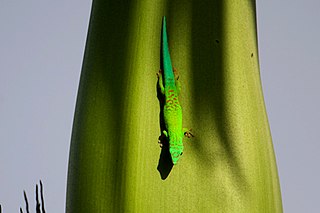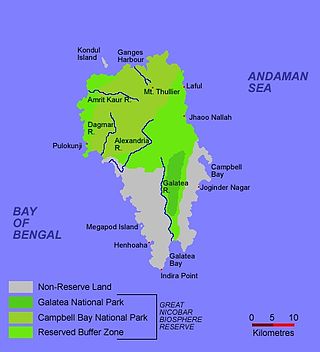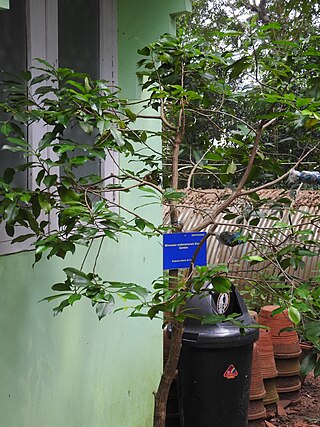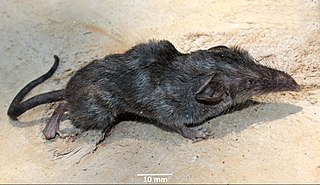
The Andaman day gecko, also known as the Andaman Islands day gecko, is a species of gecko in the genus Phelsuma. It is endemic to the Andaman Islands of India, and has recently been introduced to the Nicobar islands. It is a small, slender lizard, has a bright green colour and feeds on insects. Its range is nearly 5000 km away from the centre of the distribution area of the genus Phelsuma, in Mauritius and Madagascar.

The Great Nicobar Biosphere Reserve encompasses a large part of the island of Great Nicobar, the largest of the Nicobar Islands in the Indian Union Territory of Andaman and Nicobar Islands. The Nicobars lie in the Bay of Bengal, eastern Indian Ocean, 190 km to the north of the Indonesian island of Sumatra. The Reserve has a total core area of approximately 885 km2, surrounded by a 12 km-wide "forest buffer zone". In year 2013 it was included in the list of Man and Biosphere program of UNESCO to promote sustainable development based on local community effort and sound science.
The Andaman worm snake is a species of harmless blind snake in the family Gerrhopilidae. The species is endemic to the Andaman Islands. No subspecies are currently recognized.

Boiga andamanensis, known commonly as the Andaman cat snake, is a species of rear-fanged snake in the family Colubridae. The species is endemic to the Andaman Islands.

Dendrelaphis cyanochloris, commonly known as Wall's bronzeback or the blue bronzeback, is a species of snake found in Southeast Asia.

Dendrelaphis humayuni, also known commonly as the Nicobar bronzeback or Tiwari's bronzeback, is a species of snake in the family Colubridae. The species is endemic to the Nicobar Islands of India.

Bungarus andamanensis, the South Andaman krait, is a species of krait, a venomous elapid snake, which is found in the Andaman Islands of India.

Mount Harriet National Park, officially renamed as Mount Manipur National Park, is a national park located in the Andaman and Nicobar Islands union territory of India. The park, established in 1969, covers about 4.62 km2 (18.00 mi2). Mount Manipur, which is a part of the park, is the third-highest peak in the Andaman and Nicobar archipelago next to Saddle Peak in North Andaman and Mount Thullier in Great Nicobar.

Dendrelaphis is a genus of colubrid snakes, distributed from Pakistan, India and southern China to Indonesia, Timor-Leste, the Philippines, Australia, New Guinea and the Solomon Islands. There are over forty described species. Asian species are known commonly as bronzebacks, while the Australo-Papuan species are simply called treesnakes. All are non-venomous and entirely harmless to humans.
Minervarya andamanensis, commonly known as the Andaman frog, chestnut-brown frog, or Andaman wart frog is a species of frog only found in the Andaman Islands, India. It has been regarded as a synonym of Limnonectes limnocharis, but is now considered a valid species. A related, unnamed species exists in western Thailand.

The Andaman coucal or brown coucal is a species of non-parasitic cuckoo found in the Andamans, Coco and Table Islands. It is sometimes treated as a subspecies of the greater coucal. It is found mainly in forested habitats and thickly covered gardens.

The Andaman drongo is a species of bird in the family Dicruridae. The species is endemic to the Andaman Islands of the Indian Ocean. There are two subspecies, the nominate race being found across the main islands of the archipelago, and the race dicruriformis occurring on Great Coco Island and Table Island in the north of the chain.

Phoenix andamanensis is a wild relative of date palm endemic to the Andaman Islands in the Bay of Bengal southwest of Myanmar. It is rather a newly described taxon by Sasha C. Barrow in 1998 based on old herbarium collections. This taxon was known only from a few herbarium collections and a few insignificant citations by Kurz in 1870, Brandis in 1906 and Parkinson in 1923. The Herbarium collections were made mostly during the British regime in 1903, 1904 and 1911 by Rogers and Osmaton. Later, Ellis from the Botanical Survey of India in 1990 collected one specimen from the Saddle Peak. The specimens were remained unidentified at herbaria until its circumscription as new taxon by Barrow in 1998.

The Andaman shrew or Andaman white-toothed shrew is a critically endangered species of mammal in the family Soricidae. It is endemic to the South Andaman Island of India. They are usually active by twilight or in the night and have specialized habitat requirements. Habitat loss due to selective logging, natural disasters such as tsunami and drastic weather change are thought to contribute to current population declines.

The Andaman crow is a species of nymphalid butterfly in the Danainae subfamily. It is found in India and Burma.

Pinanga andamanensis is one of the critically endangered species of endemic palms reported from the Andaman Islands.

Pseudocalotes andamanensis is an agamid lizard found on the Nicobar Islands and the Andaman Islands in India. It is also known as the green crestless forest lizard, Andaman and Nicobar forest lizard, Andaman lizard, or Andaman green calotes. This species is an almost exclusive canopy dweller, and is rarely seen.

Chaetodon andamanensis, commonly known as the Andaman butterflyfish, is a species of marine ray-finned fish, a butterflyfish belonging to the family Chaetodontidae. It is native to the Indian Ocean.

Mimusops andamanensis is a species of plant in the family Sapotaceae. It is native to Sri Lanka and the Andaman Islands.

The Narcondam shrew is a white-toothed shrew in the family Soricidae. It is endemic to Narcondam Island, a small, remote, volcanic island situated in Andaman Sea and considered part of the Andaman and Nicobar archipelago. It was discovered in April 2020 and was described about a year later in 2021.



















